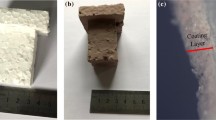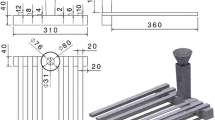Abstract
Lost-foam casting (LFC) is one of the most straightforward techniques to produce complex shaped parts with intricate geometries. However, obtained microstructures are generally coarse in nature due to the slow solidification process. In a previous study, the application of direct water cooling (DWC) in the LFC was proposed with two different approaches. The microstructural features of the water-cooled specimens were found quite promising. In this study, the effects of the DWC were investigated in terms of cooling behaviors, formation of the microstructural elements, and hardness and tensile properties of the lost-foam cast parts of A356 alloy at two different melting temperatures. Secondary dendrite arm spacing and the distance between eutectic particle values were dramatically decreased by the early-stage application of the DWC. The obtained mechanical values were found to be improved compared to the reference samples of both temperatures in terms of tensile strength, elongation to break, and hardness. In addition, selected specimens were subjected to an aging treatment right after the DWC process. The highest obtained mechanical values were found around to be approximately 195 ± 3.5 MPa ultimate tensile strength, 4.45 ± 0.78% elongation, and 84 ± 1.77 HB in hardness. The partial age hardenability of the produced parts with decent percent elongation values might cut off the dependency on the high energy-consuming solution heat treatment process.












Similar content being viewed by others
References
ASM International. Handbook Committee, Expandable-Mold Casting Processes with Expendable Patterns, in ASM Handbook ed. by J. L. Jorstad, Volume 15 Casting (ASM International, 2008), pp. 635–663
M. Paradis, M.H. Abdelaziz, F.H. Samuel, H.W. Doty, Inter. Metalcast. (2017). https://doi.org/10.1007/s40962-016-0097-4
K.A. Guler, Lost Foam Cast. (Disposable Pattern) (2016). https://doi.org/10.1016/b978-0-12-803581-8.03558-x
T.N. Chakherlou, Y.V. Mahdinia, A. Akbari, Mater Des. (2011). https://doi.org/10.1016/j.matdes.2010.06.015
S. Acar, K.A. Guler, Inter. Metalcast. (2021). https://doi.org/10.1007/s40962-020-00420-7
W. Jiang, Z. Fan, Front. Mech. Eng. (2018). https://doi.org/10.1007/s11465-018-0473-2
D. Sui, Q. Han, Inter. Metalcast. (2021). https://doi.org/10.1007/s40962-021-00603-w
J. Grassi, J. Campbell, M. Hartlieb, F. Major, Mater Sci Forum. (2009). https://doi.org/10.4028/www.scientific.net/MSF.618-619.591
D. Weiss, J. Grassi, B. Schultz, P. Rohatgi, Ablation of hybrid metal matrix composites. AFS Trans. 119, 35–41 (2011)
V. Bohlooli, M.S. Mahalli, S.M.A. Boutorabi, Acta Metall Sin Engl. (2013). https://doi.org/10.1007/s40195-012-0092-6
P. Dudek, A. Fajkiel, T. Reguła, Solid State Phenom. (2015). https://doi.org/10.4028/www.scientific.net/SSP.223.70
M. Taghipourian, M. Mohammadaliha, S.M. Boutorabi, S.H. Mirdamadi, J. Mater. Process. Technol. (2016). https://doi.org/10.1016/j.jmatprotec.2016.05.004
S.M.A. Boutorabi, P. Torkaman, J. Campbell, A. Zolfaghari, Inter Metalcast. (2020). https://doi.org/10.1007/s40962-020-00466-7
M. Tiryakioǧlu, P.D. Eason, J. Campbell, Mater. Sci. Eng. A. (2013). https://doi.org/10.1016/j.msea.2012.08.124
E. Heidari, S.M.A. Boutorabi, M.T. Honaramooz, J. Campbell, Inter Metalcast. (2021). https://doi.org/10.1007/s40962-021-00579-7
A. Kheirabi, M. Divandari, S.M.A. Boutorabi, Inter Metalcast. (2021). https://doi.org/10.1007/s40962-021-00672-x
ASM International. Handbook Committee, ASM Handbook, Volume 9 Metallography and Microstructures (ASM International, 1985)
X. Jian, Q. Han, Formation of hypereutectic silicon particles in hypoeutectic Al–Si alloys under the influence of high-intensity ultrasonic vibration. China Foundry 10(2), 118–123 (2013)
J. Santos, A.E.W. Jarfors, A.K. Dahle, Metall. Mater. Trans. A Phys. Metall. Mater. Sci. (2021). https://doi.org/10.1007/s11661-021-06462-8
S.R. Wang, R. Ma, Y.Z. Wang, Y. Wang, L.Y. Yang, Trans. Nonferrous Met. Soc. China (2012). https://doi.org/10.1016/S1003-6326(11)61314-9
L. Backerüd, G. Chai, J. Tamminen, Solidification Characteristics of Aluminum Alloys, Vol. 2. Foundry Alloys (American Foundry Society. Inc., Stockholm, 1990)
D. Schwarzenbach, Crystallography (John Wiley & Sons, Chichester, 1996), p.116
L. Bolzoni, N.H. Babu, Appl. Mater. Today (2016). https://doi.org/10.1016/j.apmt.2016.11.001
C. Choudhary, H.N. Bar, A.K. Pramanick, K.L. Sahoo, D. Mandal, Met. Mater. Int. (2022). https://doi.org/10.1007/s12540-021-01154-9
C. Choudhary, K.L. Sahoo, H. Roy, D. Mandal, J Mater Eng Perform. (2022). https://doi.org/10.1007/s11665-021-06413-9
R.K. Yajjala, N.M. Inampudi, B.R. Jinugu, J. Mater. Res. Technol. (2020). https://doi.org/10.1016/j.jmrt.2020.02.066
Acknowledgements
This work is funded by TÜBİTAK (The Scientific and Technological Research Council of Turkey, Grant Number: 120M819).
Author information
Authors and Affiliations
Corresponding author
Additional information
Publisher's Note
Springer Nature remains neutral with regard to jurisdictional claims in published maps and institutional affiliations.
Rights and permissions
Springer Nature or its licensor (e.g. a society or other partner) holds exclusive rights to this article under a publishing agreement with the author(s) or other rightsholder(s); author self-archiving of the accepted manuscript version of this article is solely governed by the terms of such publishing agreement and applicable law.
About this article
Cite this article
Tutuk, I., Acar, S. & Guler, K.A. The Application of the Direct Water Cooling Process on the Lost-Foam Casting Technique to Improve Microstructural and Mechanical Properties of A356 Alloy. Inter Metalcast 17, 2324–2337 (2023). https://doi.org/10.1007/s40962-022-00950-2
Received:
Accepted:
Published:
Issue Date:
DOI: https://doi.org/10.1007/s40962-022-00950-2




